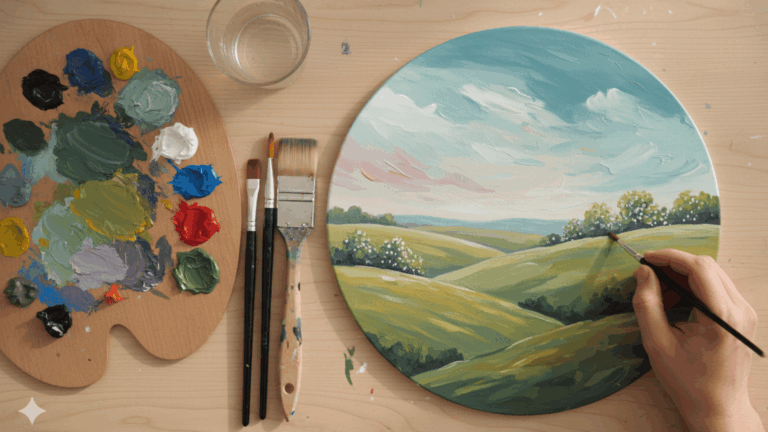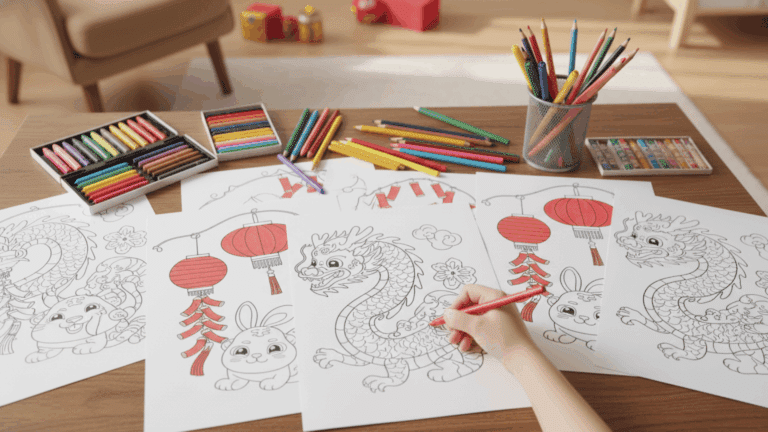Brown is a color that often goes unnoticed, yet it plays a fundamental role in the natural world.
In this blog post, we deal with the richness of brown, uncovering its presence across diverse categories.
Brown is everywhere, from the subtle brown hues of common animals like deer and squirrels to the deep browns of fertile soils that nurture plant life.
We’ll also examine how this earthy color appears in rocks and minerals, river features, and bird plumage.
This blog celebrates the understated beauty and crucial ecological significance of the color brown by highlighting the variety of brown things in nature.
List of Brown Things in Nature
1. Animals
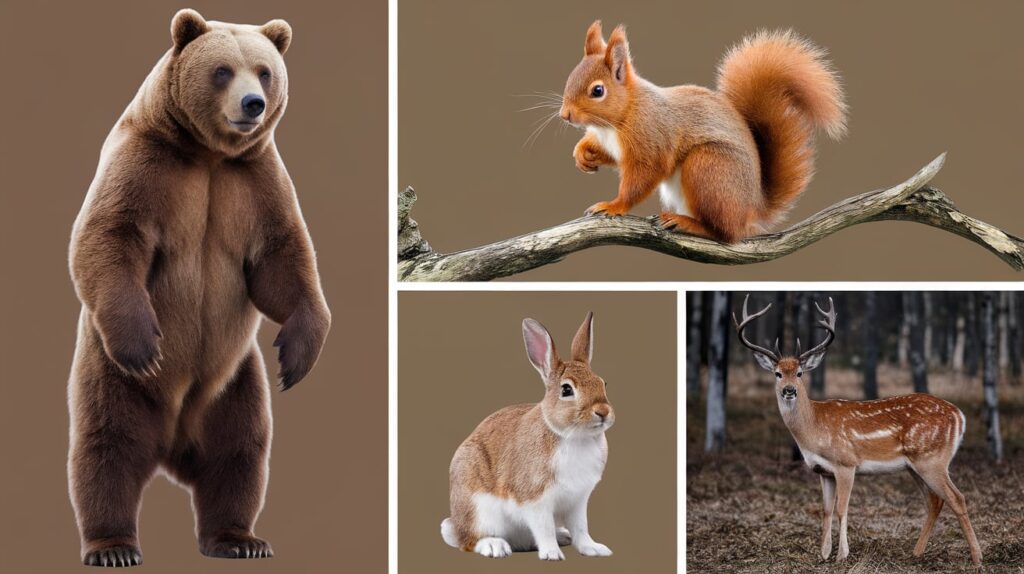
- Brown bear: A large bear species known for its thick brown fur, primarily found in the forests of North America and Eurasia.
- Deer: Commonly seen with a brown coat, deer are graceful creatures that adapt well to various habitats.
- Beaver: Known for their brown fur, flat tails, and impressive dam-building skills.
- Moose: The largest species of the deer family, characterized by their dark brown bodies and massive antlers.
- Squirrel: Often sporting a brown, bushy tail, squirrels are nimble rodents that live in trees and are known for their quick movements.
- Chipmunk: Small, striped rodents with brown coloring, known for stuffing their cheeks with food.
- Field mouse: Typically brown, these small rodents are common in grasslands and agricultural areas.
- Coyote: A versatile predator with a light brown coat, found in North and Central America.
- Brown rat: One of the most widespread rodents, recognized by its brownish fur and long tail.
- Rabbit: Often found with various shades of brown fur, rabbits are known for their long ears and fast breeding.
- Marmot: These large ground squirrels have a brownish coat and live in mountainous areas.
- Vole: Small, brown, mouse-like rodents that live in underground burrows or in grassy fields.
- Woodchuck: Also known as groundhogs, these creatures have a grizzled brown coat and are famous for their burrowing habits.
2. Plants
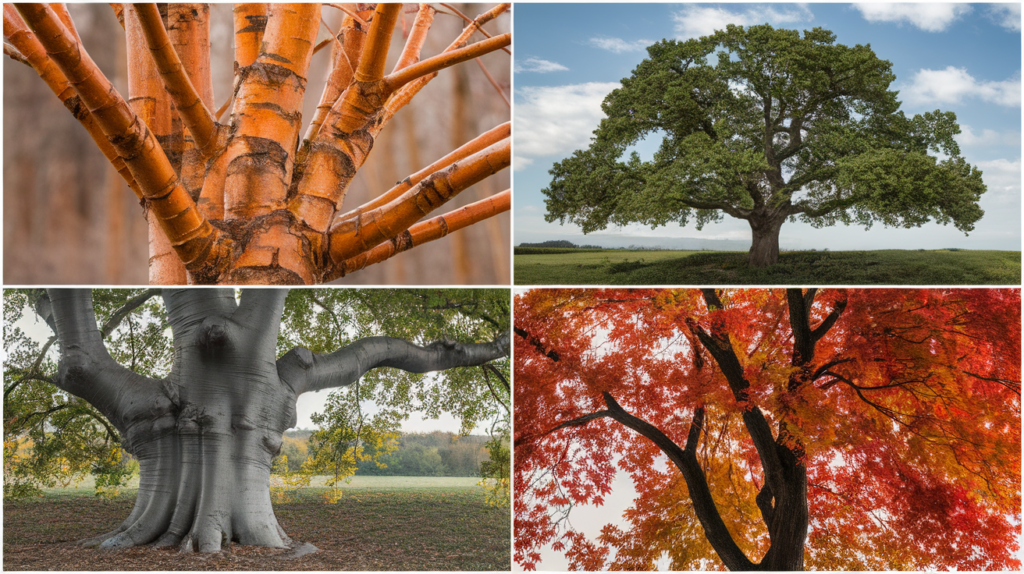
- Oak tree: Known for its strength and longevity, it has a characteristic dark brown bark.
- Walnut tree: Valued for its nuts and beautiful wood, walnut trees have deeply furrowed brown bark.
- Cedar tree: Recognized by its reddish-brown bark, cedar trees are often used in woodworking for their aromatic wood.
- Cinnamon tree: The bark of this tree is harvested as a cinnamon spice, featuring a warm brown color.
- Mahogany tree: Famous for its reddish-brown wood used in fine furniture.
- Maple tree: Known for its vibrant fall colors and valuable sap, maples have light brown bark.
- Sequoia tree: One of the tallest and oldest trees, sequoias have a distinctive reddish-brown bark.
- Chestnut tree: Produces edible nuts and has a brown, rugged bark.
- Pine tree: Evergreen conifers often have a rough brown bark and are widely used in the lumber industry.
- Willow tree: Known for its graceful drooping branches and brown bark, often found near water sources.
- Beech tree: Features smooth, light brown bark and is known for its sturdy and attractive wood.
- Elm tree: Once widespread, these trees are known for their distinctive dark brown, deeply grooved bark.
- Acacia tree: Notable for its unique leaves and brown bark, acacias are important in ecosystems for their nitrogen-fixing abilities.
3. Soils and Sands
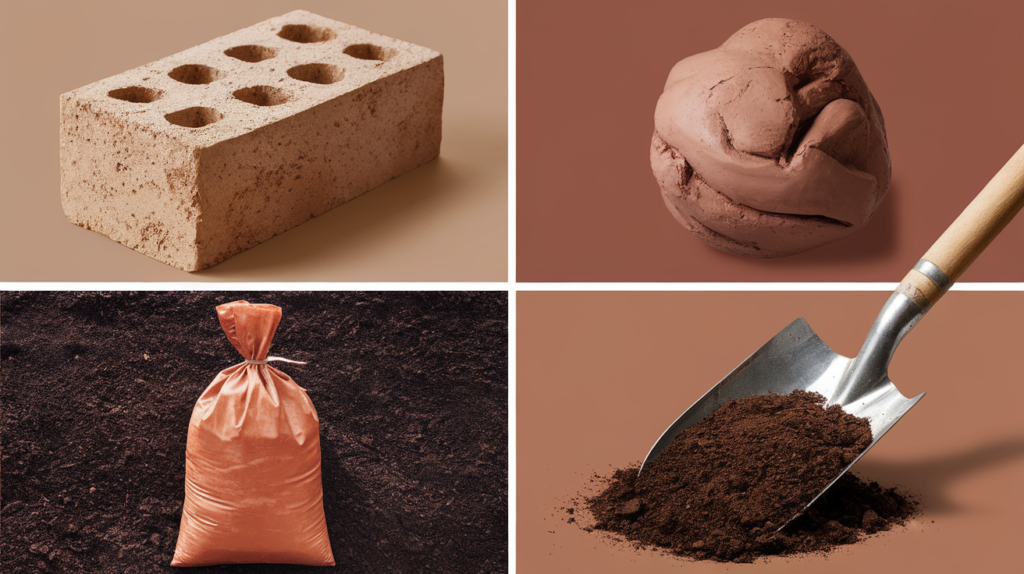
- Loam: A fertile brown soil type due to its balanced mixture of sand, silt, and clay.
- Clay: Often found in a range of brown colors, clay is sticky when wet and hard when dry, used in ceramics.
- Peat: Dark brown soil-like material formed from decomposed vegetation in wet environments, used as fuel and in gardening.
- Chalk: Less commonly brown, but certain types contain clay impurities that give a brownish tint.
- Silt: Fine-grained soil with a light brown color, often deposited by water.
- Sandstone soil: Derived from compacted sandstone, this soil can range from light to dark brown.
- Garden soil: Typically rich, dark brown, and full of organic material, ideal for planting and gardening.
- Topsoil: The uppermost layer of soil, usually darker brown due to its organic matter content.
- Potting soil: Commercially prepared and often dark brown, used for growing plants in containers.
- Compost: Decayed organic matter that is dark brown and nutrient-rich, excellent for improving garden soil.
- Fill dirt: It is generally brown and consists of a mixture of soils. It is used for filling holes or leveling ground.
- Peaty soil: Dark brown or black, rich in decomposed plant material, found in wetlands.
- Brown sandy loam: A type of soil particularly good for agriculture, combining sand, silt, and clay.
4. Rocks and Minerals
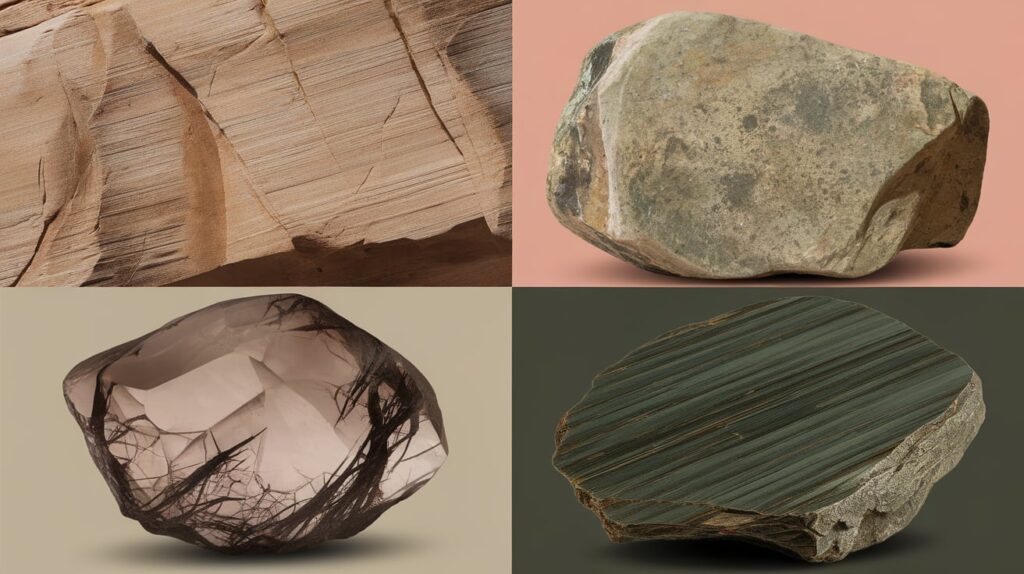
- Sandstone: A common sedimentary rock that can be various shades of brown, often used in building and paving.
- Brown agate: A banded form of finely-grained quartz, usually brown, and used as a gemstone.
- Jasper: An opaque rock of virtually any color stemming from the mineral content but often found in earthy browns.
- Tiger’s eye: A chatoyant gemstone with golden to red-brown color and silky luster.
- Smoky quartz: A type of quartz that ranges from light brown to nearly black, used in jewelry and decoration.
- Brown zircon: A mineral commonly found in granites and metamorphic rocks, used as a gemstone in its brown form.
- Aragonite: Typically found in marine shells and pearls, often displaying a pale brown color.
- Desert rose: Crystal clusters of gypsum or baryte, including abundant sand grains, thus appearing brown.
- Limonite: An iron ore that is typically brownish and is one of the main sources of iron.
- Bronzite: A mineral that is a brown-colored form of enstatite and is used in jewelry and ornamental stone.
- Sepia garnet: The rare garnet variety, with a unique deep brown color, is often sought after by collectors.
- Axinite: A rare brown to violet-brown mineral that forms sharp, glassy crystals.
- Petrified wood: Wood turned to stone through permineralization, typically brown due to iron compounds.
5. Fungi
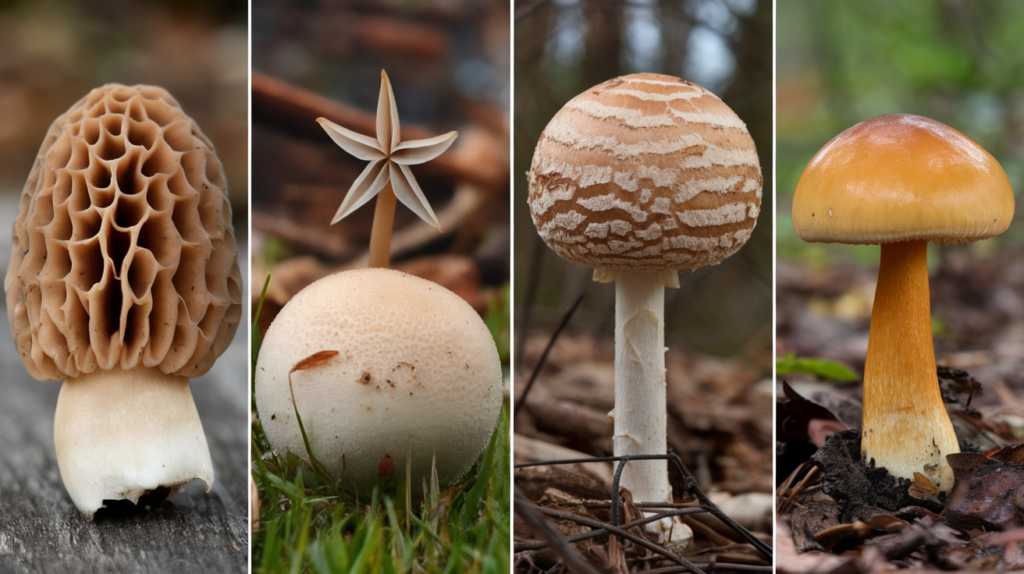
- Porcini mushroom: A prized edible mushroom with a rich brown color and a distinctive nutty flavor.
- Shiitake mushroom: Known for its meaty texture, it has a brown cap and is popular in many cuisines.
- Morel mushroom: These distinctive fungi have a honeycomb appearance on their brown caps and are highly sought after.
- Portobello mushroom: Larger and more mature, these mushrooms have a dense, meaty texture and deep brown color.
- Cremini mushroom: Often referred to as baby portobellos, these are lighter brown and firm in texture.
- Earthstar: This fungus is recognized by its star-shaped base and brown color on forest floors.
- Puffball mushroom: These round fungi can be identified by their brown color when mature and their unique shape.
- Chanterelle mushrooms: Known for their funnel shape and brown or yellow color, they are popular for their flavor.
- Hen of the woods: A bracket fungus that grows in clusters resembling the tail feathers of a hen, typically brown.
- King bolete: A highly esteemed edible mushroom featuring a large brown cap and thick stem.
- Turkey tail mushroom: These fungi are named for their striking multicolored, fan-shaped appearance, often featuring brown.
- Slippery Jack: Characterized by its slimy, brown cap, this mushroom is commonly found in wet conditions.
- Cinnamon jelly fungus: Noted for its gelatinous, orange-brown appearance, growing typically on decaying wood.
6. Natural Fibers
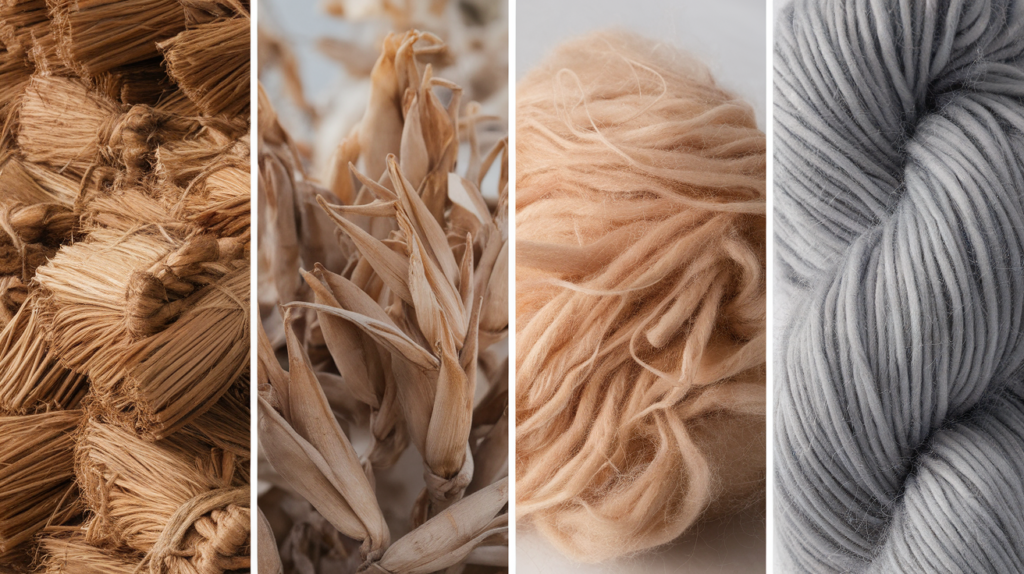
- Jute: A long, soft, shiny vegetable fiber that can be spun into coarse, strong threads, often brown when unbleached.
- Sisal: Derived from the Agave sisalana plant, this fiber is traditionally used for rope, and twine, naturally brown.
- Hemp: This versatile fiber is extracted from the cannabis plant and is typically seen in a natural brown shade when unprocessed.
- Flax: Used to make linen, flax fibers are naturally light brown and are known for their durability and strength.
- Manilla hemp: Made from the fibers of the abacá, a type of banana plant, it is generally a creamy brown used in rope making.
- Coir: Made from the husk of coconuts, coir is a coarse, brown fiber used in products like floor mats and brushes.
- Alpaca wool: Sourced from the fleece of the alpaca, this wool can range from light to dark brown and is prized for its softness and warmth.
- Camel wool: Typically a natural brown color, camel wool is collected from camels and used in high-quality coats and sweaters.
- Cashmere: Derived from cashmere goats, this fiber’s natural brown color is rare and highly valued for its softness.
- Mohair: Produced from the hair of the Angora goat, it is often dyed, but its natural color can be a light brown.
- Angora wool: Comes from the Angora rabbit, and while often white, can also be found in natural shades of brown.
- Bison wool: Rare and luxurious, bison wool is naturally brown and known for its warmth.
- Yak wool: Sourced from yaks, this wool is naturally dark brown and is incredibly warm and durable.
7. Seeds and Nuts
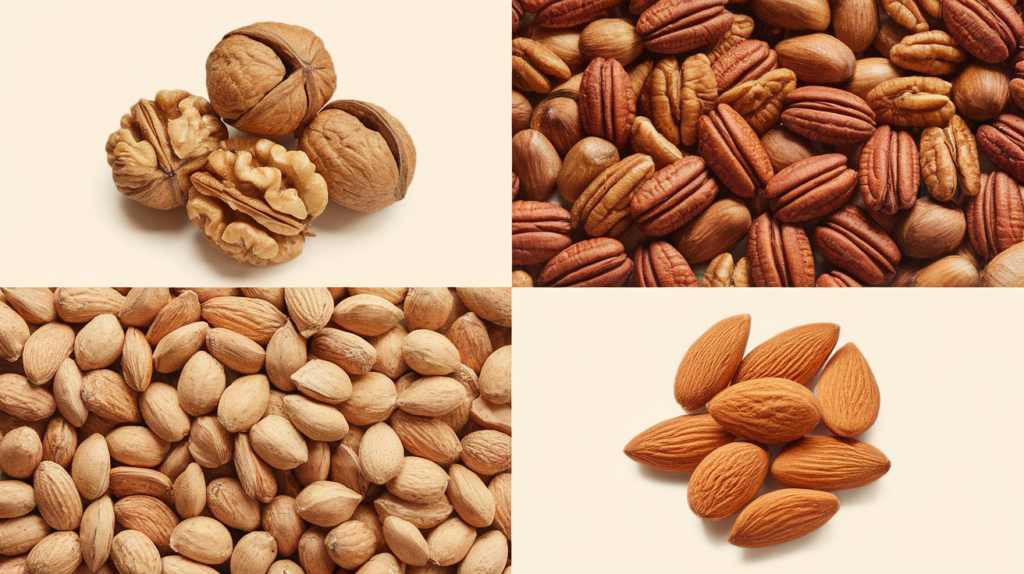
- Walnut: Known for its wrinkled appearance and brain-like shape, walnuts have a dark brown shell.
- Acorn: The oak tree nut, typically encapsulated in a tough, brown shell.
- Chestnut: Enclosed in a spiky husk, the chestnut is glossy brown and sweet when cooked.
- Pecan: Pecans are smooth, brown, and oblong, popular in baking for their buttery flavor.
- Hazelnut: Small and round with a hard, brown shell, hazelnuts are commonly used in chocolates and pastries.
- Brazil nut: Encased in a thick, brown shell, Brazil nuts are large and rich in selenium.
- Macadamia nut: Native to Australia, these nuts have a hard, brown shell and are prized for their creamy taste.
- Almond: Typically sold with a light brown skin, almonds are crunchy and ideal for snacks and almond milk.
- Pine nut: Harvested from pine cones, these small nuts are elongated and encased in a hard, brown shell.
- Beech nut: Small and triangular, beech nuts come from the beech tree and have a light brown, tough outer shell.
- Buckeye nut: These dark brown nuts, which resemble the eye of a deer, come from the buckeye tree.
- Earth almond: Also known as tiger nuts, these tubers are chewy, sweet, and wrapped in a brown skin.
- Butternut: This type of walnut is oblong and has a rough, brown outer shell with a rich, buttery flavor inside.
8. Dead Plant Materials
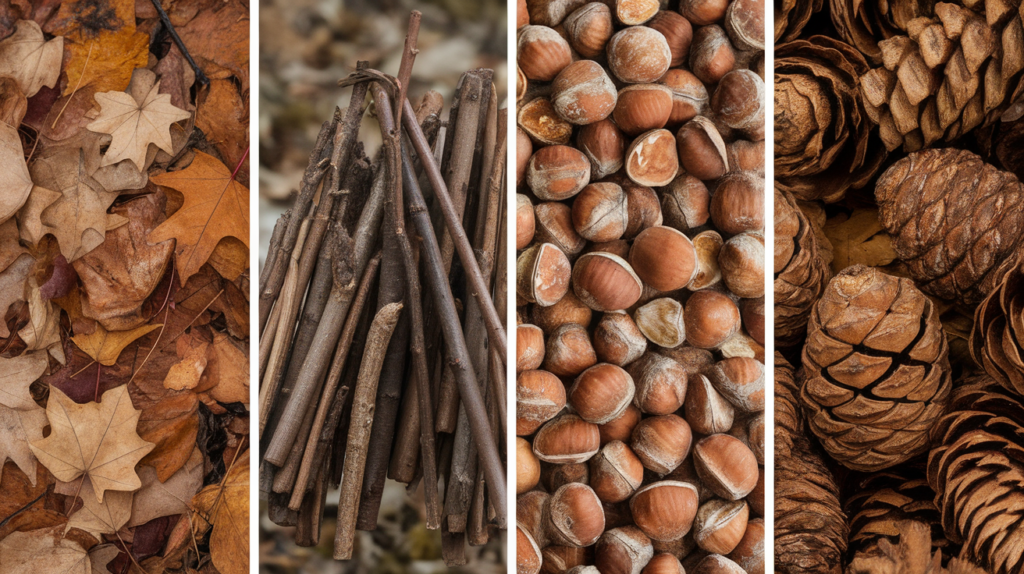
- Pine cones: Typically brown, these woody cones protect pine trees’ seeds and add rustic charm to decorations.
- Fallen leaves: As leaves decompose, they often turn shades of brown, enriching the soil with nutrients.
- Dead wood: Generally brown, dead wood is found on the forest floor and plays a crucial role in natural ecosystems by providing habitat and returning nutrients to the soil.
- Bark chips: Brown bark chips are commonly used in landscaping. They help retain soil moisture and control weeds.
- Mulch: Often brown, mulch is used to insulate the soil and keep gardens healthy.
- Twigs: Small and brown, twigs fall from trees and contribute to the forest debris.
- Dried ferns: Once vibrant green, ferns turn a light brown when dried, often used in floral arrangements for a touch of nature.
- Old roots: Exposed roots become brown over time and are visible along tree bases or eroded areas.
- Nutshells: After the nut is removed, the hard, brown shells remain, often used in crafting or as natural mulch.
- Seed pods: Many plants produce brown seed pods that house the seeds until they are ready to disperse.
- Corn husks: Once dried, corn husks turn a pale brown and are used in culinary recipes and crafts.
- Dead moss: When moss dies, it turns brown, contrasting sharply with its usual vibrant green.
- Driftwood: Found along shorelines, driftwood is weathered and brown, popular for home decor and art projects.
9. Freshwater Features
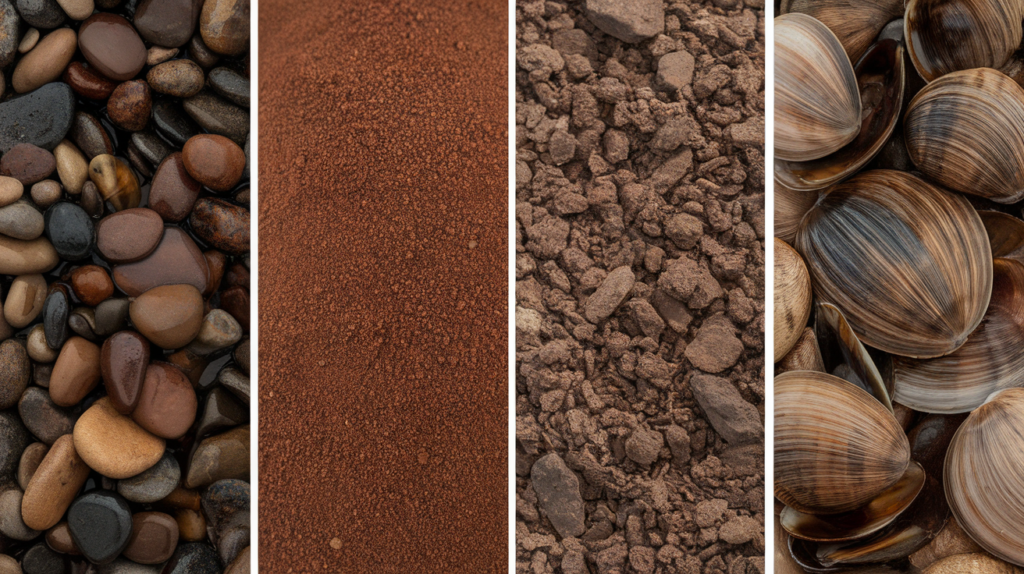
- River pebbles: Smoothed over time, these small stones are often found in shades of brown along riverbeds.
- Lake sediment: Composed of organic material and minerals, this sediment can appear brown and is essential for aquatic ecosystems.
- Creek stones: Found in and around creeks, these stones are typically brown and smoothed by flowing water.
- Freshwater silt: Fine and brown, silt accumulates on riverbeds and lake floors, playing a vital role in the aquatic food web.
- Riverbank mud: Rich and brown, this mud is found along riverbanks and is often teeming with life.
- Wet sand: Near freshwater bodies, sand can appear brown when saturated with water.
- River driftwood: Carried by river currents, this wood is typically weathered and has a brown appearance.
- Freshwater clams: These bivalves often have brown shells and live buried in the sediment of freshwater environments.
- Waterside rocks: Constantly smoothed by water, these rocks can take on various brown hues.
- Bank foliage: Plants along river and lake banks often have brown stems and branches, especially during the off-season.
- River algae: Some types of algae that grow in freshwater environments have a brownish color.
- Streambed gravel: This gravel, which comes in various shades of brown, lines the beds of streams and other small bodies of water.
- Lakebed sand: This sand, which can appear brown and is often mixed with organic materials, is found at the bottoms of lakes.
10. Birds
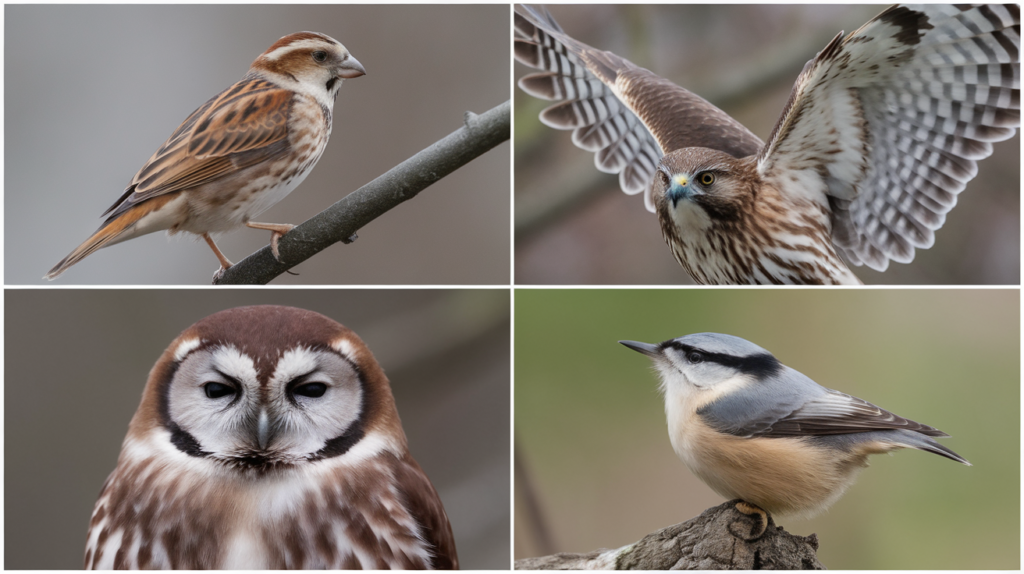
- Sparrow: Many sparrow species have brown plumage, which helps them blend into their surroundings.
- Hawk: Several hawk species, like the Red-tailed hawks, have brown coloring that aids camouflage.
- Owl: Owls like the Tawny Owl have brown feathers, essential for nocturnal hunting and stealth.
- Thrush: Birds like the Song Thrush have brown backs and spotted breasts, ideal for their ground-dwelling lifestyle.
- Quail: These ground birds have brown plumage, helping them hide from predators in their natural habitat.
- Turkey: Wild turkeys boast brown feathers that help them blend into the forest during their foraging.
- Woodcock: This bird’s mottled brown plumage makes it almost invisible in its woodland home.
- Wren: Small and quick, wrens have a predominantly brown coloration that keeps them hidden in underbrush.
- Finch: The House Finch features a brownish back with more colorful breast markings.
- Pheasant: Pheasants are a popular game bird known for their long tails and brown bodies.
- Nuthatch: Typically brown, nuthatches use their coloring to camouflage against the bark of trees while they forage.
- Starling: In their non-breeding season, starlings have a brownish hue that changes to glossy black in summer.
- Dove: Doves like the Mourning Dove have soft brown feathers, which provide excellent camouflage in open fields or perched on telephone wires.
Summing Up
Brown is a color deeply rooted in nature, appearing in countless forms across the natural world. In wildlife, animals like the brown bear and field mouse use their earthy tones for camouflage and survival.
In the plant world, brown signifies growth and renewal, seen in the trunks of trees and the richness of fertile soil.
Even non-living elements, such as river stones and sediment layers, wear shades of brown that shape the earth’s diverse landscape.
This exploration of brown in nature reveals its quiet strength and essential presence in maintaining balance and beauty throughout the environment.
Visit our website to learn more about other lists of specific colors. Check out our collections, which focus on different colors in nature, each bringing its unique touch to the world around us.









